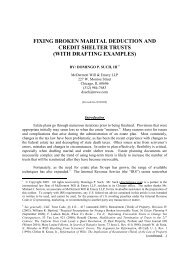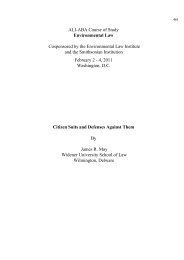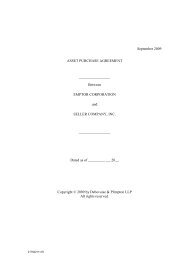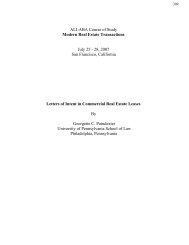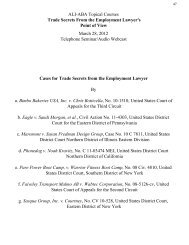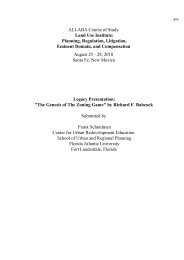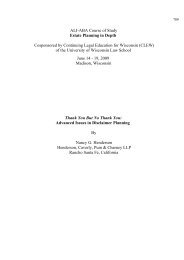Section 125 â Cafeteria Plans - ALI CLE
Section 125 â Cafeteria Plans - ALI CLE
Section 125 â Cafeteria Plans - ALI CLE
Create successful ePaper yourself
Turn your PDF publications into a flip-book with our unique Google optimized e-Paper software.
45<br />
THE AMERICAN LAW INSTITUTE<br />
Continuing Legal Education<br />
Implementing the Affordable Care Act for Employer<br />
<strong>Plans</strong>: What to Focus on Now<br />
July 19, 2012<br />
Telephone Seminar/Audio Webcast<br />
<strong>Section</strong> <strong>125</strong> – <strong>Cafeteria</strong> <strong>Plans</strong><br />
Notice 2012-40<br />
Internal Revenue Service
46<br />
<strong>Section</strong> <strong>125</strong> - <strong>Cafeteria</strong> <strong>Plans</strong><br />
Health flexible spending arrangements not subject to $2,500 limit on salary reduction<br />
contributions for plan years beginning before 2013 and comments requested on<br />
potential modification of use-or-lose rule.<br />
Notice 2012-40<br />
I. PURPOSE AND OVERVIEW<br />
This notice provides guidance on the effective date of the $2,500 limit (as<br />
indexed for inflation) on salary reduction contributions to health flexible spending<br />
arrangements (health FSAs) under § <strong>125</strong>(i) of the Internal Revenue Code (Code) (the<br />
$2,500 limit) and on the deadline for amending plans to comply with that limit. This<br />
notice also provides relief for certain contributions that mistakenly exceed the $2,500<br />
limit and that are corrected in a timely manner. Finally, the notice requests comments<br />
on whether to modify the use-or-lose rule that is currently set forth in the proposed<br />
regulations with respect to health FSAs.<br />
Specifically, this notice provides that –<br />
• the $2,500 limit does not apply for plan years that begin before 2013;<br />
• the term “taxable year” in § <strong>125</strong>(i) refers to the plan year of the cafeteria plan as<br />
this is the period for which salary reduction elections are made;<br />
• plans may adopt the required amendments to reflect the $2,500 limit at any time<br />
through the end of calendar year 2014;<br />
• in the case of a plan providing a grace period (which may be up to two months<br />
and 15 days), unused salary reduction contributions to the health FSA for plan<br />
years beginning in 2012 or later that are carried over into the grace period for
47<br />
that plan year will not count against the $2,500 limit for the subsequent plan year;<br />
and<br />
• relief is provided for certain salary reduction contributions exceeding the $2,500<br />
limit that are due to a reasonable mistake and not willful neglect and that are<br />
corrected by the employer.<br />
The statutory $2,500 limit under § <strong>125</strong>(i) applies only to salary reduction contributions<br />
under a health FSA, and does not apply to certain employer non-elective contributions<br />
(sometimes called flex credits), to any types of contributions or amounts available for<br />
reimbursement under other types of FSAs, health savings accounts, or health<br />
reimbursement arrangements, or to salary reduction contributions to cafeteria plans that<br />
are used to pay an employee’s share of health coverage premiums (or the<br />
corresponding employee share under a self-insured employer-sponsored health plan).<br />
II.<br />
BACKGROUND<br />
A § <strong>125</strong> cafeteria plan is a written plan that allows employees to elect between<br />
permitted taxable benefits (such as cash) and certain qualified benefits. <strong>Section</strong> <strong>125</strong>(a),<br />
(d)(1). If an employee makes the election before the start of the plan year, and other<br />
§ <strong>125</strong> requirements are satisfied, the employee’s election of one or more qualified<br />
benefits does not result in gross income to the employee.<br />
In 2007, the Treasury Department and the Internal Revenue Service (IRS)<br />
published proposed regulations under § <strong>125</strong>. 72 Fed. Reg. 43938 (Aug. 6, 2007).<br />
Taxpayers may rely on the proposed regulations. The proposed regulations require a<br />
written cafeteria plan providing a health FSA to specify the maximum salary reduction<br />
contribution as a maximum dollar amount, a maximum percentage of compensation, or<br />
2
48<br />
other method of determining the maximum salary reduction contribution. See Prop.<br />
Treas. Reg. § 1.<strong>125</strong>-1(c). If a cafeteria plan fails to operate in compliance with § <strong>125</strong> or<br />
fails to satisfy any of the written plan requirements for health FSAs, the plan is not a<br />
§ <strong>125</strong> cafeteria plan and an employee’s election of nontaxable benefits results in gross<br />
income to the employee. For additional guidance, see Prop. Treas. Reg. § 1.<strong>125</strong>-<br />
1(c)(1), (c)(6) and (c)(7).<br />
A cafeteria plan may include a grace period of up to two months and 15 days<br />
immediately following the end of a plan year. If the plan provides for a grace period, an<br />
employee may use amounts remaining from the previous plan year (including amounts<br />
remaining in a health FSA) to pay for expenses incurred for certain qualified benefits<br />
during the grace period. See Notice 2005-42, 2005-1 C.B. 1204, and Prop. Treas. Reg.<br />
§ 1.<strong>125</strong>-1(e).<br />
<strong>Section</strong> <strong>125</strong>(i) was added by § 9005 of the Patient Protection and Affordable<br />
Care Act (the Act), Pub. L. No. 111-148 (as amended by § 10902 of the Act, and further<br />
amended by § 1403(b) of the Health Care and Education Reconciliation Act of 2010,<br />
Pub. L. No. 111-152). <strong>Section</strong> <strong>125</strong>(i) is effective for “taxable years” beginning after<br />
December 31, 2012. Prior to the effective date of § <strong>125</strong>(i), plan sponsors imposed limits<br />
on the amount of salary reduction contributions that employees may elect to health<br />
FSAs, but there has been no statutory limit.<br />
III.<br />
COMPLIANCE WITH THE $2,500 LIMIT ON SALARY REDUCTION<br />
CONTRIBUTIONS TO HEALTH FSAS<br />
<strong>Section</strong> <strong>125</strong>(i) provides that a health FSA is not treated as a qualified benefit<br />
unless the cafeteria plan “provides that an employee may not elect for any taxable year<br />
to have salary reduction contributions in excess of $2,500 made to such arrangement.”<br />
3
49<br />
Because employees make salary reduction contribution elections for health FSAs only<br />
on a plan year basis (see Prop. Treas. Reg. § 1.<strong>125</strong>-2), the term “taxable year” in §<br />
<strong>125</strong>(i) (which does not specify that it refers, for example, to the employee’s taxable year<br />
or to the employer’s taxable year) refers to the plan year of the cafeteria plan. Similarly,<br />
the reference to “taxable year” in the effective date provision of § <strong>125</strong>(i) refers to the<br />
plan year of the cafeteria plan. Accordingly, the $2,500 limit on health FSA salary<br />
reduction contributions applies on a plan year basis and is effective for plan years<br />
beginning after December 31, 2012. Also, the $2,500 limit will be indexed for cost-ofliving<br />
adjustments for plan years beginning after December 31, 2013. See General<br />
Explanation of Tax Legislation Enacted in the 111th Congress (2011), Joint Committee<br />
on Taxation, at 317.<br />
A § <strong>125</strong> cafeteria plan may offer only qualified benefits. A plan that offers a<br />
nonqualified benefit is not a § <strong>125</strong> cafeteria plan. <strong>Section</strong> <strong>125</strong>(d)(1)(B); see also Prop.<br />
Treas. Reg. § 1.<strong>125</strong>-1(q). Accordingly, a cafeteria plan that fails to comply with § <strong>125</strong>(i)<br />
for plan years beginning after December 31, 2012 is not a § <strong>125</strong> cafeteria plan and the<br />
value of the taxable benefits that an employee could have elected to receive under the<br />
plan during the plan year is includible in employee’s gross income, regardless of the<br />
benefit elected by the employee. See Prop. Treas. Reg. § 1.<strong>125</strong>-1(b). As explained<br />
below, the cafeteria plan must be amended to reflect the $2,500 limit, and must also<br />
comply with the $2,500 limit in operation.<br />
Consistent with Prop. Treas. Reg. § 1.<strong>125</strong>-1(d)(2), a plan year is permitted to be<br />
changed only for a valid business purpose. If a principal purpose of changing from a<br />
calendar year to a fiscal year is to delay the application of the $2,500 limit, the change is<br />
4
50<br />
not for a valid business purpose. If a change in the plan year does not satisfy this valid<br />
business purpose requirement, the plan year for the cafeteria plan remains the plan<br />
year that was in effect prior to the attempted change.<br />
If a cafeteria plan has a short plan year (that is, fewer than 12 months) that<br />
begins after 2012, the $2,500 limit must be prorated based on the number of months in<br />
that short plan year.<br />
The $2,500 limit on salary reduction contributions to a health FSA applies on an<br />
employee-by-employee basis. Thus, $2,500 (as indexed for inflation) is the maximum<br />
salary reduction contribution each employee may make for a plan year, regardless of<br />
the number of other individuals (for example, a spouse, dependents, or adult children<br />
(see § 105(b)) whose medical expenses are reimbursable under the employee’s health<br />
FSA. Consistent with this rule, if each of two spouses is eligible to elect salary<br />
reduction contributions to an FSA, each spouse may elect to make salary reduction<br />
contributions of up to $2,500 (as indexed for inflation) to his or her health FSA, even if<br />
both participate in the same health FSA sponsored by the same employer.<br />
All employers that are treated as a single employer under § 414(b), (c), or (m),<br />
relating to controlled groups and affiliated service groups, are treated as a single<br />
employer for purposes of the $2,500 limit. If an employee participates in multiple<br />
cafeteria plans offering health FSAs maintained by members of a controlled group or<br />
affiliated service group, the employee’s total health FSA salary reduction contributions<br />
under all of the cafeteria plans are limited to $2,500 (as indexed for inflation). <strong>Section</strong><br />
<strong>125</strong>(g)(4). However, an employee employed by two or more employers that are not<br />
5
51<br />
members of the same controlled group may elect up to $2,500 (as indexed for inflation)<br />
under each employer’s health FSA.<br />
As noted, the $2,500 limit applies only to salary reduction contributions and not to<br />
employer non-elective contributions, sometimes called flex credits. Generally, an<br />
employer may make flex credits available to an employee who is eligible to participate in<br />
the cafeteria plan, to be used (at the employee’s election) only for one or more qualified<br />
benefits. For further information on flex credits, see Prop. Treas. Reg. § 1.<strong>125</strong>-5(b).<br />
For example, if an employer contributes a $500 flex credit to each employee’s health<br />
FSA for the 2013 plan year, each employee may still elect to make salary reduction<br />
contributions of $2,500 (as indexed for inflation) to a health FSA for that plan year.<br />
However, if an employer provides flex credits that employees may elect to receive as<br />
cash or as a taxable benefit, those flex credits are treated as salary reduction<br />
contributions for purposes of § <strong>125</strong>(i).<br />
The statute imposes the $2,500 limit only on salary reduction contributions to a<br />
health FSA in a cafeteria plan and does not limit the amount permitted for<br />
reimbursement under other employer-provided coverage, such as employee salary<br />
reduction contributions to an FSA for dependent care assistance or adoption care<br />
assistance. The limit also does not apply to salary reduction contributions to a cafeteria<br />
plan that are used to pay an employee’s share of health coverage premiums (or the<br />
corresponding employee share under a self-insured employer-sponsored health plan) --<br />
sometimes referred to as “premium conversion” salary reduction contributions -- nor<br />
does it apply to salary reduction or any other contributions to a health savings account<br />
6
52<br />
(HSA) or to amounts made available by an employer under a health reimbursement<br />
arrangement (HRA).<br />
If a plan provides for a grace period (which, as noted above, can be no longer<br />
than two months and 15 days) for a plan year, unused salary reduction contributions to<br />
the health FSA for the plan year that are carried over into the grace period do not count<br />
against the $2,500 limit applicable for the subsequent plan year.<br />
If a cafeteria plan timely complies with the written plan requirement limiting health<br />
FSA salary reduction contributions as set forth in section IV, below, but one or more<br />
employees are erroneously allowed to elect a salary reduction of more than $2,500 (as<br />
indexed for inflation) for a plan year, the cafeteria plan will continue to be a § <strong>125</strong><br />
cafeteria plan for that plan year if (1) the terms of the plan apply uniformly to all<br />
participants (consistent with Prop. Treas. Reg. § 1.<strong>125</strong>-1(c)(1)); (2) the error results<br />
from a reasonable mistake by the employer (or the employer’s agent) and is not due to<br />
willful neglect by the employer (or the employer’s agent); and (3) salary reduction<br />
contributions in excess of $2,500 (as indexed for inflation) are paid to the employee and<br />
reported as wages for income tax withholding and employment tax purposes on the<br />
employee’s Form W-2, Wage and Tax Statement (or Form W-2c, Corrected Wage and<br />
Tax Statement) for the employee’s taxable year in which, or with which, ends the<br />
cafeteria plan year in which the correction is made.<br />
The relief provided in this section III with respect to erroneous excess<br />
contributions is not available for an employer if a federal tax return of the employer is<br />
under examination with respect to benefits provided under a cafeteria plan with respect<br />
to any cafeteria plan year during which the failure to comply with § <strong>125</strong>(i) occurred. For<br />
7
53<br />
this purpose, an employer is treated as under examination if the employer receives<br />
written notification (for example, by plan examination, information document request<br />
(IDR), or notification of proposed adjustments to a federal tax return) from the<br />
examining agent(s) specifically citing § <strong>125</strong>(i) as an issue under consideration.<br />
IV.<br />
WRITTEN CAFETERIA PLAN AMENDMENT<br />
A cafeteria plan offering a health FSA must be amended to set forth the $2,500<br />
limit (or, at the employer’s option, a lower limit specified in the plan). <strong>Cafeteria</strong> plan<br />
amendments may be effective only prospectively. See Prop.Treas. Reg. § 1.<strong>125</strong>-1(c).<br />
Notwithstanding this rule against retroactive amendments, an amendment to conform a<br />
cafeteria plan to the requirements of § <strong>125</strong>(i) that is adopted on or before December 31,<br />
2014, may be made effective retroactively, provided that the cafeteria plan operates in<br />
accordance with the requirements of § <strong>125</strong>(i) (including the guidance under this notice)<br />
for plan years beginning after December 31, 2012. This amendment to the written<br />
cafeteria plan may be expressed as a maximum dollar amount or by another method of<br />
determining the maximum dollar amount of salary reduction contributions to a health<br />
FSA, but in no case may the plan permit a participant to make salary reduction<br />
contributions, for a plan year beginning after December 31, 2012, exceeding the $2,500<br />
limit.<br />
V. EXAMPLES<br />
The rules of this notice are illustrated by the following examples. For all<br />
examples, it is assumed that the cafeteria plan otherwise satisfies all of the<br />
requirements of § <strong>125</strong> and the proposed regulations, and that the employer is not a<br />
member of a controlled group or affiliated service group.<br />
8
54<br />
Example 1. (i) Employer W offers a calendar year cafeteria plan including a health<br />
FSA. Employer W amends its written cafeteria plan by December 31, 2014, to provide<br />
that, effective for the plan year beginning on January 1, 2013, employee salary<br />
reduction contributions to a health FSA are limited to $2,500 (as indexed for inflation).<br />
(ii)<br />
Employer W’s written cafeteria plan satisfies the requirements of § <strong>125</strong>(i).<br />
Example 2. (i) Employer X offers a calendar year cafeteria plan including a health FSA<br />
with a grace period of two months and 15 days that complies with Notice 2005-42 and<br />
the proposed regulations. Effective for the 2012 plan year, the written plan provides<br />
that employee salary reduction contributions for the health FSA are limited to $5,000.<br />
Effective for the 2013 plan year, the written plan provides that employee salary<br />
reduction contributions to the health FSA are limited to $2,500 (as indexed for inflation).<br />
Some employees have unused amounts from their 2012 health FSA salary reduction<br />
contributions that remain available during the grace period in the first two months and<br />
15 days of 2013.<br />
(ii) The availability during the grace period of amounts attributable to 2012 health<br />
FSA salary reduction contributions does not cause Employer X’s cafeteria plan to fail to<br />
satisfy the $2,500 limit.<br />
VI.<br />
EFFECTIVE DATES<br />
Under the guidance provided in this notice, section <strong>125</strong>(i) applies to plan years<br />
beginning after December 31, 2012. Indexing of the $2,500 limit applies to plan years<br />
beginning after December 31, 2013.<br />
VII.<br />
EFFECT ON OTHER DOCUMENTS<br />
The Treasury Department and the IRS intend to amend the regulations under<br />
§§ 1.<strong>125</strong>-1, 1.<strong>125</strong>-2, and 1.<strong>125</strong>-5 to provide for the $2,500 limit, and taxpayers may rely<br />
on the foregoing guidance in this notice pending issuance of the amended regulations.<br />
VIII.<br />
REQUEST FOR COMMENTS ON POSSIBLE MODIFICATION OF USE-OR-<br />
LOSE RULE FOR HEALTH FSAS<br />
In light of the $2,500 limit, the Treasury Department and the IRS are considering<br />
whether, for health FSAs, the position contained in proposed regulations that is often<br />
referred to as the “use-or-lose” rule” should be modified. That rule generally prohibits<br />
9
55<br />
any contribution or benefit under an FSA from being used in a subsequent plan year or<br />
period of coverage. See Prop. Treas. Reg. § 1.<strong>125</strong>-1, Q&A-7(b) (1984); Prop. Treas.<br />
Reg. § 1.<strong>125</strong>-2, Q&A-5 & Q&A-7 (1989); Prop. Treas. Reg. § 1.<strong>125</strong>-5(c) (2007). Thus,<br />
under this rule, unused amounts in the health FSA are “forfeited” at the end of the plan<br />
year.<br />
The $2,500 limit, while not addressing the “use-or-lose” rule, limits the potential<br />
for using health FSAs to defer compensation and the extent to which salary reduction<br />
amounts may accumulate over time. Given the $2,500 limit, the Treasury Department<br />
and the IRS are considering whether the use-or-lose rule for health FSAs should be<br />
modified to provide a different form of administrative relief (instead of, or in addition to,<br />
the current 2½ month grace period rule). Comments are requested on whether the<br />
proposed regulations should be modified to provide additional flexibility with respect to<br />
the operation of the use-or-lose rule for health FSAs and, if so, how any such flexibility<br />
might be formulated and constrained. Comments are also requested on how any such<br />
modifications would interact with the $2,500 limit.<br />
This section VIII of this notice does not constitute guidance and may not be relied<br />
upon by taxpayers.<br />
Comments must be submitted by August 17, 2012. Comments should include a<br />
reference to Notice 2012-40. Send submissions to CC:PA:LPD:PR (Notice 2012-40),<br />
Room 5203, Internal Revenue Service, P.O. Box 7604, Ben Franklin Station,<br />
Washington, DC 20044. Submissions may be hand delivered Monday through Friday<br />
between the hours of 8 a.m. and 4 p.m. to CC:PA:LPD:PR (Notice 2012-40), Courier’s<br />
Desk, Internal Revenue Service, 1111 Constitution Avenue, NW, Washington, DC<br />
10
56<br />
20044, or sent electronically, via the following e-mail address:<br />
Notice.comments@irscounsel.treas.gov. Please include “Notice 2012-40” in the subject<br />
line of any electronic communication. All material submitted will be available for public<br />
inspection and copying.<br />
DRAFTING INFORMATION<br />
The principal author of this notice is Elizabeth Purcell of the Office of Division<br />
Counsel/Associate Chief Counsel (Tax Exempt and Government Entities). For further<br />
information regarding this notice contact Ms. Purcell at (202) 622-6080 (not a toll-free<br />
call).<br />
11




